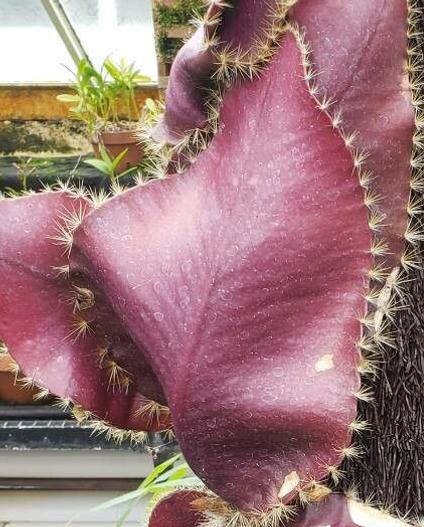Amazon Moonflower
(Strophocactus wittii)
Amazon Moonflower (Strophocactus wittii)
/
/

William Coville
CC BY-SA 4.0
Image By:
William Coville
Recorded By:
Copyright:
CC BY-SA 4.0
Copyright Notice:
Photo by: William Coville | License Type: CC BY-SA 4.0 | License URL: https://creativecommons.org/licenses/by-sa/4.0 | Uploader: Mockingbard | Publisher: Wikipedia Commons


















Estimated Native Range
Summary
Strophocactus wittii, commonly known as the Amazon moonflower, is a perennial epiphytic cactus native to the seasonally inundated rainforests of the central Amazon basin. It typically grows on tree trunks and branches, adapting well to the fluctuating water levels of its habitat. This species has distinctive flattened, leaf-like stems that can turn a reddish hue when exposed to strong sunlight. The Amazon moonflower is renowned for its large, nocturnal, white flowers that bloom for a single night and emit a potent fragrance to attract pollinators such as bats and moths. The flowers are exceptionally showy, and their brief blooming period adds an element of rarity and excitement for gardeners. The seeds of Strophocactus wittii are adapted for water dispersal, which is a unique trait within the cactus family.
The Amazon moonflower is cultivated primarily for its spectacular flowering event and its unusual growth habit as an epiphyte. It is a popular choice for tropical and subtropical greenhouse collections, and it can be grown on bark or moss in conditions that mimic its natural habitat. In cultivation, it requires high humidity, consistent moisture during the growing season, and a well-draining substrate to prevent root rot. It thrives in partial shade to filtered sunlight. While it is not commonly used in outdoor landscaping due to its specific requirements, it is a prized specimen for indoor plant enthusiasts. Care should be taken to avoid overwatering, as this can lead to fungal diseases.CC BY-SA 4.0
The Amazon moonflower is cultivated primarily for its spectacular flowering event and its unusual growth habit as an epiphyte. It is a popular choice for tropical and subtropical greenhouse collections, and it can be grown on bark or moss in conditions that mimic its natural habitat. In cultivation, it requires high humidity, consistent moisture during the growing season, and a well-draining substrate to prevent root rot. It thrives in partial shade to filtered sunlight. While it is not commonly used in outdoor landscaping due to its specific requirements, it is a prized specimen for indoor plant enthusiasts. Care should be taken to avoid overwatering, as this can lead to fungal diseases.CC BY-SA 4.0
Plant Description
- Plant Type: Tree, Succulent
- Height: 2-5 feet
- Width: 1-2 feet
- Growth Rate: Slow
- Flower Color: White
- Flowering Season: Summer
- Leaf Retention: Deciduous
Growth Requirements
- Sun: Part Shade
- Water: Medium
- Drainage: Fast
Common Uses
Fragrant, Low Maintenance, Potted Plant, Showy Flowers
Natural Habitat
Seasonally inundated rainforests of the central Amazon basin
Other Names
Common Names: Large-flowered Cactus, Dutchman’s Pipe Cactus
Scientific Names: , Strophocactus wittii, Cereus wittii, Selenicereus wittii,
GBIF Accepted Name: